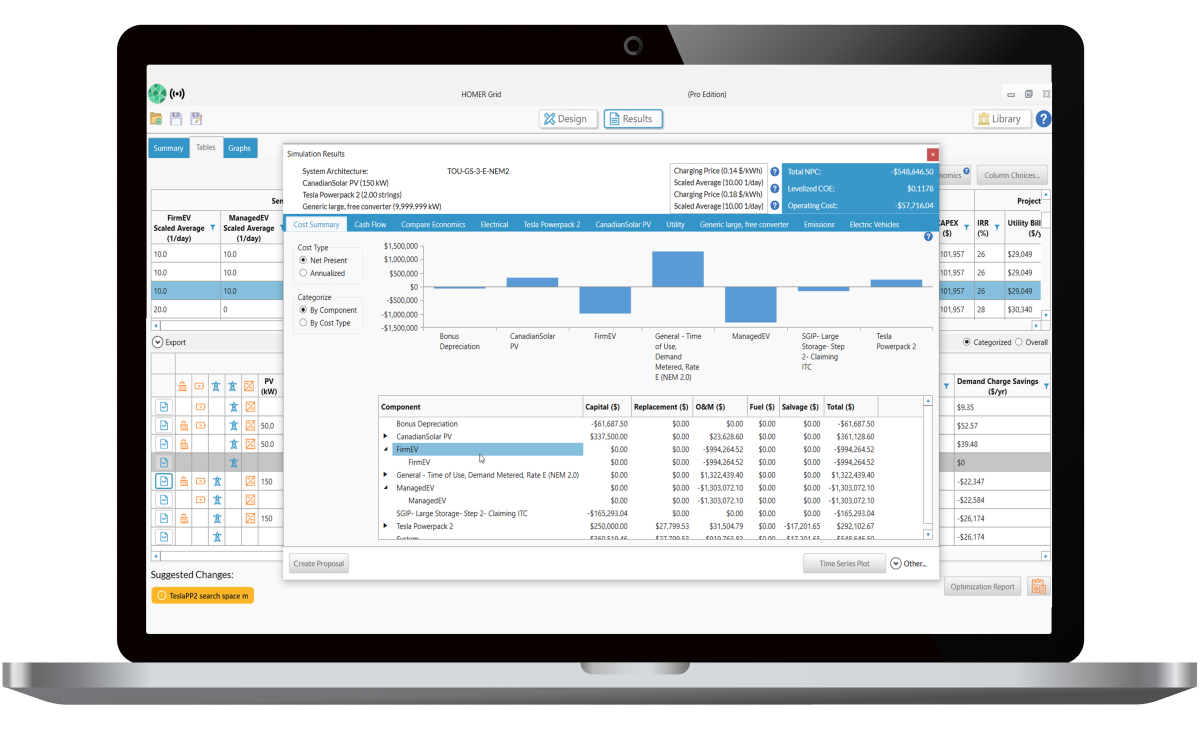Now, project developers can confidently forecast revenue and return on investment (ROI) of proposed charging stations, maximize project value and demonstrate that value to customers in minutes.

Boulder, Colo. – Sept. 18, 2023 – UL Solutions, a global leader in applied safety science, unveiled the powerful new 1.10 version of HOMER Grid modeling software, developed to assist with speeding up and simplifying designing and optimizing renewable distributed energy-plus-storage powered electric vehicle (EV) charging stations, which may allow for the maximizing of their potential revenue and return-on-investment (ROI).
With the rapid rise of EVs, energy project developers, engineering firms and EV charging station providers increasingly need to evaluate a proposed charging station’s costs, revenue and performance in the project feasibility stage. HOMER Grid 1.10 enables users to rapidly calculate potential EV charging revenue based on user-defined charging prices and the costs of supplying electricity from the grid or using on-site renewable generation and storage. These new features join HOMER Grid’s robust modeling of on-demand fast charging and managed or deferrable “smart” mode charging when time-of-use energy rates are lowest. The software enables project developers to reduce the time and uncertainty of evaluating the ROI of a proposed, site-specific, renewable energy-plus-storage powered charging station, maximize the project’s value, and demonstrate that value to customers. Modeling results can also help speed the permitting process, reduce the time from quote to construction, and provide cost-savings and revenue generation data that mitigates project risk and may result in better financing terms.
Extensive databases for electric loads, utility tariffs, incentives, demand response programs, solar irradiance and other weather data are integrated into HOMER Grid, allowing developers to analyze the feasibility of a prospective location and powering system configuration and compare multiple sites quickly.
“With HOMER Grid, developers can determine the best and least-cost system to power a charging station in minutes. Using the software’s sensitivity analysis engine, they can assess the interplay of real-life variables, like day-to-day fluctuations in charging demand and time-of-use electricity rates. Developers can confidently forecast revenue and ROI, which helps all stakeholders understand the project’s full value and speed up decision-making,” said Parangat Bhaskar, product manager, HOMER Software, UL Solutions.
 To perform the analysis, HOMER Grid runs thousands of simulations, optimizing scenarios for multiple complex variables within minutes — including electric loads, utility tariffs, time-of-use charges, incentive programs, grid-power outages, local generation and battery storage, capital expenditures, operating costs and payback periods for solar — and determines the least-cost solution. With HOMER Grid’s technical and economic modeling, designers can:
To perform the analysis, HOMER Grid runs thousands of simulations, optimizing scenarios for multiple complex variables within minutes — including electric loads, utility tariffs, time-of-use charges, incentive programs, grid-power outages, local generation and battery storage, capital expenditures, operating costs and payback periods for solar — and determines the least-cost solution. With HOMER Grid’s technical and economic modeling, designers can:
- Perform robust forecast analysis.
- Maximize the revenue and return on investment.
- Minimize the impact on the power grid.
- Minimize risks by identifying high-probability scenarios and explicitly modeling worst-case scenarios.
- Confidently provide their customers with EV charging revenue projections.
“Ultimately, information is power. HOMER Grid helps minimize uncertainty with simulation results and thus may help increase stakeholders’ confidence in the feasibility of a proposed EV charging station. Homer GRID may assist with projects being developed faster and more efficiently, with potentially more predictable outcomes,” Bhaskar said.
EV sales are projected to rise steeply, and the federal government and private sector are investing in building EV charging infrastructure. However, the successful adoption of EVs on the expected scale will require access to reliable charging stations nationwide — a challenging task.
“It’s not as easy as deciding to add EV charging to your parking lot and doing it. The increased electric load will likely exceed the existing power grid’s capability to supply this new and complex load type safely and sustainably. And upgrading the grid is a long, costly undertaking. Customers foot the bill for such costly upgrades in many ways, including huge jumps in demand charges. The solution lies in building renewable energy microgrids or other distributed energy resources (DERs) to power charging stations and minimizing the impact on the local grid. HOMER Grid enables the firms that will provide those charging stations to do so successfully and with confidence. Research has shown that a successful EV charging experience drives up the charging customer’s loyalty to that business,” said Bhaskar.
Other updates to HOMER Grid 1.10 include the addition of California’s new Net Energy Metering (NEM) 3.0 tariffs, which strengthen incentives for solar-plus-storage systems in that state. Additionally, HOMER Grid allows users to import project production data from other design software. A new enhancement enables users to import multiple data files — from multiple solar photovoltaic (PV) arrays, for example — to be combined into a single energy modeling project in HOMER Grid 1.10.
With recently updated utility tariffs, HOMER Grid software integrates more than 90% of tariffs from the United States (U.S.), Mexico and Canada. The software also allows the creation of custom tariffs, enabling more accurate modeling of energy project costs as utility pricing continues to evolve.
HOMER Grid is built on the benchmark-setting HOMER platform, developed at the U.S. Department of Energy’s National Renewable Energy Laboratory (NREL). HOMER software has completed over 250,000 project calculations in 190+ countries, distributed across thousands of active companies that trust HOMER for their projects.
Learn more about HOMER Grid modeling software.
See a demonstration of the new features by registering for the Sept. 28, 2023 webinar, “Electrify Your Parking Lot: Successfully Forecast EV Charging Revenue and Cost in Seven Easy Steps.”
About UL Solutions
A global leader in applied safety science, UL Solutions transforms safety, security and sustainability challenges into opportunities for customers in more than 100 countries. UL Solutions delivers testing, inspection and certification services, together with software products and advisory offerings, that support our customers’ product innovation and business growth. The UL Certification Marks serve as a recognized symbol of trust in our customers’ products and reflect an unwavering commitment to advancing our safety mission. We help our customers innovate, launch new products and services, navigate global markets and complex supply chains and grow sustainably and responsibly into the future. Our science is your advantage.
PRESS CONTACT:
Steven Brewster, UL Solutions
T: +1 (847) 664.8425
